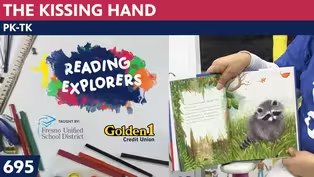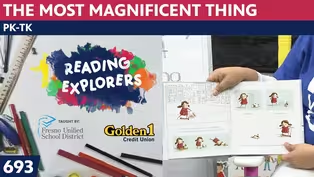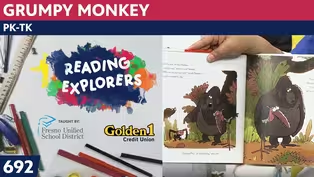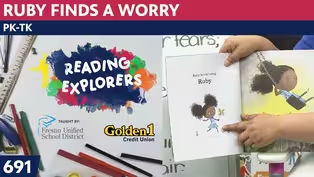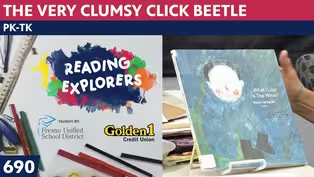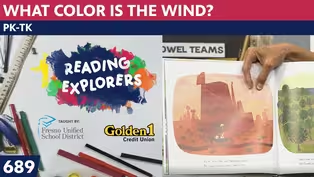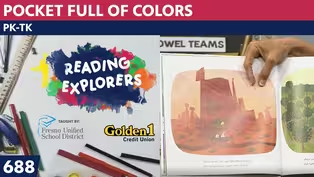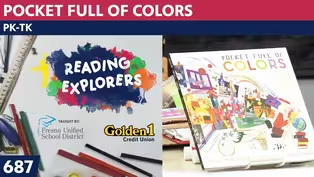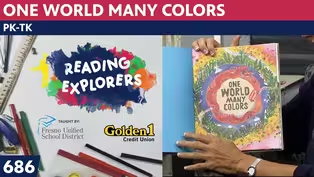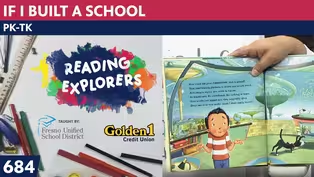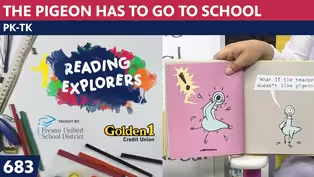
TK-338: Friedensreich Hundertwasser
Season 3 Episode 204 | 14m 12sVideo has Closed Captions
Join Mrs. Readwright at Camp Discovery!
Transitional Kindergarten teacher, Mrs. Readwright, welcomes students back to Camp Discovery, a fun learning space packed with reading adventures & fun games!
Problems playing video? | Closed Captioning Feedback
Problems playing video? | Closed Captioning Feedback
Reading Explorers is a local public television program presented by Valley PBS

TK-338: Friedensreich Hundertwasser
Season 3 Episode 204 | 14m 12sVideo has Closed Captions
Transitional Kindergarten teacher, Mrs. Readwright, welcomes students back to Camp Discovery, a fun learning space packed with reading adventures & fun games!
Problems playing video? | Closed Captioning Feedback
How to Watch Reading Explorers
Reading Explorers is available to stream on pbs.org and the free PBS App, available on iPhone, Apple TV, Android TV, Android smartphones, Amazon Fire TV, Amazon Fire Tablet, Roku, Samsung Smart TV, and Vizio.
Providing Support for PBS.org
Learn Moreabout PBS online sponsorshipMore from This Collection
Valley PBS and Fresno Unified School District have partnered with Golden 1 Credit Union to create Reading Explorers Lessons for grades Pre-Kindergarten through Third grade. The daily lessons will be taught by Fresno Unified School District teachers and are created to help students practice their reading skills and reinforce lessons during distance learning.
Video has Closed Captions
Valley PBS presents Reading Explorers Lessons for Pre-Kindergarten and TK. (26m 27s)
PK-TK-693-The Most Magnificent Thing
Video has Closed Captions
Valley PBS presents Reading Explorers Lessons for Pre-Kindergarten and TK. (26m 26s)
Video has Closed Captions
Valley PBS presents Reading Explorers Lessons for Pre-Kindergarten and TK. (26m 28s)
Video has Closed Captions
Valley PBS presents Reading Explorers Lessons for Pre-Kindergarten and TK. (26m 28s)
PK-TK-690: The Very Clumsy Click Beetle
Video has Closed Captions
Valley PBS presents Reading Explorers Lessons for Pre-Kindergarten and TK. (26m 22s)
PK-TK-689: What Color is the Wind?
Video has Closed Captions
Valley PBS presents Reading Explorers Lessons for Pre-Kindergarten and TK. (26m 21s)
PK-TK-688: Pocket Full of Colors
Video has Closed Captions
Valley PBS presents Reading Explorers Lessons for Pre-Kindergarten and TK. (25m 58s)
PK-TK-687: Dancing Through Fields of Colors
Video has Closed Captions
Valley PBS presents Reading Explorers Lessons for Pre-Kindergarten and TK. (26m 20s)
PK-TK-686: One World Many Colors
Video has Closed Captions
Valley PBS presents Reading Explorers Lessons for Pre-Kindergarten and TK. (27m 13s)
PK-TK-685: School is Wherever I am
Video has Closed Captions
Valley PBS presents Reading Explorers Lessons for Pre-Kindergarten and TK. (26m 32s)
PK-TK-684: If I Built a School
Video has Closed Captions
Valley PBS presents Reading Explorers Lessons for Pre-Kindergarten and TK. (26m 21s)
PK-TK-683: The Pigeon Has to Go to School
Video has Closed Captions
Valley PBS presents Reading Explorers Lessons for Pre-Kindergarten and TK. (26m 22s)
Providing Support for PBS.org
Learn Moreabout PBS online sponsorship(upbeat guitar music) ♪ Good morning to a brand new day ♪ ♪ Time to learn and the games to play ♪ ♪ Learning things is so much fun ♪ ♪ Learning is good for everyone ♪ (playful music) - Hello, early learners.
Welcome back to the art room.
It's me, Mrs. Readwright.
Remember this week, we're doing the ABCs of Art.
So let's start out with our hello song.
♪ Hello, nice to see you, everyone ♪ ♪ Hello, nice to see you, everyone ♪ ♪ Hello to you ♪ ♪ Hello to you ♪ ♪ Hello to you ♪ ♪ Hello to me ♪ ♪ Hello, nice to see you, everyone ♪ This week, we're doing ABCs of Art and we did ♪ A, B, C, D, E of art.
♪ ♪ F, G, ♪ Today, is H. So let's sing that song, so we see where we are.
Ooh, I just hit my, all my work from last week, we never showed it.
I finished all of it up, and I hope you take a look at it through the episode today.
And here's the song.
♪ A, B, C, D, E of art ♪ ♪ That's the way that we will start ♪ ♪ F is for fish ♪ ♪ Goldfish starts with a G ♪ ♪ H is for house, now don't use see ♪ ♪ I is for insect ♪ ♪ Jar starts with J ♪ ♪ Art and the alphabet, what do you say ♪ So today, is the letter H. And H is for house.
Let's look at the little riddle I did and listen for the rhyming words.
Hundertwasser's house lined in a row, brightly colored rooftops, all for show, row, show, they both say, O.
There they are, they're in a row, and he's showing those off.
They are colorful and bright.
Let me tell you a little bit about him.
Here he is, Friedensreich Hundertwasser.
His name used to be something else, and he wanted it to sound more impressive.
And what it means is, peace kingdom, hundred water.
So his first name is Peace Kingdom.
And his last name's Hundred Water.
What a name.
But he started out being an artist who painted, but then he became famous for his buildings.
His buildings look like this.
Here is a city that honored him, and let him build these buildings in their city.
And it looks like a little spiral wall.
He was interested in humans getting together with nature and taking care of each other, like in a circle.
I'll take care of you, nature; you take care of me.
So I'll take care of you, nature, and you take care of me.
So he planted gardens so that he could keep the earth with full of living things.
And then he would eat the things from the garden.
So that was like, he took care of nature and nature took care of him.
So his art, he thought, should be like nature.
He didn't think straight lines were important.
He thought straight lines made things look stiff.
And he said, there aren't hardly any straight lines in nature, so my art is going to look like nature.
So what we're going to do is make a row of buildings.
And I want to make sure we do these concentric circles.
Now concentric means, one inside the other, and it just gets bigger or smaller, concentric.
So we're going to look at this.
It was kind of like, how when a raindrop hits the water, pew, and it goes out, out, out, out, out, out.
So when we draw ours, you might put yours in the corner, or you might make it go through the building.
'Cause look what he did, he did these colors up here, but once they hit the building, he changed them into other colors.
So we'll draw those.
We'll make these kinds of spirally kind of rooftops.
This one has a tall roof and it has some grid in it.
Their windows come off from the side.
He doesn't put them in the middle like we see this one.
Or like we usually see children's art, we just put our windows right in the middle of our wall.
He has them coming in from the side, so they can look out.
So what we're going to do is do tall buildings.
I like the triangle roof on this.
I'm gonna make a triangle roof.
I'm just being inspired.
I'm not going to do it exactly like his.
Or maybe you'll only do two buildings.
Maybe you'll do... Let's count how many he did, and then we'll see how many you do, if it's the same or a little different.
Let's count one, two, three, four, five buildings.
I wonder if this was supposed to be sun rays coming down, I don't know.
But then those walls in the back are all just checkerboard.
All right.
Let's take a look and let's get started with ours.
Boys and girls, you know I always ask you when you're doing your art, if you would have someone take a picture of you doing your art, or when it's finished, and you send it to me.
And if you send it here, include your address.
The studio might send you one of these books.
And you can keep it in your own little library.
They're activity books that you can do all kinds of activities or projects with.
Let me put this up here, get my table up.
And my white paper.
Normally, you see me using it in a vertical way.
Today, because I'm going to do a row of houses, I'm going to turn it horizontally.
And I asked you to bring your coloring tools.
On my table, I have my colored pencils.
I have some crayons.
I have my watercolors.
So I'm just going to start out, drawing some with my colored pencils.
And I'm going to bring them over, so I don't have to keep dragging myself over here.
Now, I try to keep 'em in order, but I just saw a brown was in with my purples.
So go ahead and just start coloring your outsides of your shape.
So I'm starting out with straight lines.
And then I think I'll draw this one with a triangle roof.
I'm just gonna do the outsides of my building first, and then I'll go back in to color them.
Maybe you'll want to do that too, so that you can just see how many you're going to do.
Mine are going to overlap like his did.
I'm gonna make this one go up a little higher and a triangle roof for it, but I'm gonna make it come way out, go down to the bottom.
I'll use a different color on this one.
Maybe I'll use... Oh, that's why it's getting mixed up, 'cause I'm putting it in the wrong place.
Maybe I'll use green for this one.
This one I want a cone roof.
So a cone is just kind of like a triangle where you do two diagonal lines, but underneath it has to be curved.
And then I'll go straight down.
They don't share a wall space.
I'm doing it as carefully as I can.
I Think I'll make this one orange, and I'm gonna make it be a wide building.
So I'm going to go over, and I'm going to go... Oh!
Won't we use that one, 'cause I'll sharpen it later.
Told you how soft it is.
So maybe I should hold it sideways a little bit.
I'm gonna make that building wide and go down.
And I think to make that be the kind of fancy way they did it, I'm gonna have to make it go, have a little step up.
And now I'm gonna make it be that kind of shape.
I'm gonna make this go down, and down, and down, spiral.
Go ahead.
Oh, it's kind of how we did our pumpkins long ago.
I'm gonna make something on this one too, some kind of design.
And if I wanted it to look like his, I would make that circle come around and through it.
I'm going to make sure I do a lot of patterns on here.
I think that's what's going to make it look really super interesting is to do patterns on here, on all the rooftops, kind of like he did.
And I think I will make this one have concentric triangles in it.
He didn't do that.
That'll be a little different.
I'm getting his ideas.
But now I'm going to start coloring it in.
And how I'm going to do that is use my watercolor pencils.
I think I'm going to use this purply color, and color in here, and color in here, and here.
Getting off all of these in here.
Some colors.
Now remember, this is a project we're starting now, and I try to encourage you not to rush, because you always have your artwork at home and ready.
You can finish it up at home later.
I'm not worried about finishing mine, because like I told you, I take it home, and on the weekend when I have time to finish it, I take my time and finish it.
And then I bring it back and hang it behind me.
So you can see that, "Oh, look how she made those dancing characters "from when we were learning about William Johnson.
"She has his tie flying up from dancing "so wildly at the Harlem Nightclub."
But this, I'm painting this in.
Now, I could use my watercolor paints too, because that would make it really bright and shiny and beautiful, 'cause none of his colors are boring.
They don't just dull and lifeless.
He kept adding more and more color to it and making it very beautiful.
Underneath, I think I will use some pink, 'cause pink and purple looks good together.
You know the color, I'm telling you over and over again, I can just color a little bit, because then I can water color over the top of it and fill it in.
I don't have to fill it in with my pencil so much.
Oh, I like how that looks.
I'm going to add some windows now.
And I'm going to put my windows on this building to be blue.
And I think he only has one little one like a place where Rapunzel would let down her long hair.
So I'm going to go around it with my regular pencil.
So that would, when I brush over it with the watercolors, it won't move that color.
But I can go next to it with the blue and see what happens when I paint across.
I think that you'll have fun when you're taking this and making your houses.
'Cause you make houses, I know, at school, because teachers ask you to make a picture of your own house.
Where does your family live?
So you can just make this one in a fairy kind of land.
Or where a prince or princess might live in this castle.
Boys and girls, let me tell you about tomorrow, what our project is going to be.
Tomorrow, it's going to be the letter I.
And you'll need a piece of white paper.
I'm bringing a very skinny black pen, because we're not using any color in our art tomorrow.
It's an artist who is living now, she's just a girl, not a little girl, but she lives on her own and travels.
She spends a lot of time traveling, but she also does all black and white work.
And her insects are in famous places, and she is getting known more and more in England for her art.
And I just thought it was so interesting and fun to do a black and white.
I'm still gonna work on this while I'm telling you about tomorrow's work.
So I'm bringing a skinny black pen and white paper.
And we'll learn about Rosalind Monks.
And you notice, I'm going up and down, up and down, like we've talked about before when you're coloring.
Even when I'm with my watercolor pencils, I'm trying to get in here to make this be blended in.
Let's see.
Yep, I like the way this looks, but I think I'm gonna use some other blues and get it in there.
I'm gonna add more windows to these buildings, and add it in between.
I'd love to see yours.
I hope you'll send it to me when you are finished with it.
Or a picture of you doing it.
Boys and girls, I am thinking that we're going to be doing a bunch of different letters during the week.
And I hope that you keep singing the alphabet songs, so that you know the order of things, and get better and better about what words start with different letters.
And that's kind of why I chose this theme for us.
I'm gonna make my window off to the side.
I guess we better sing goodbye to one another.
♪ Goodbye, see you next time, everyone ♪ ♪ Goodbye, see you next time, everyone ♪ ♪ Goodbye to you ♪ ♪ Goodbye to you ♪ ♪ Goodbye to you ♪ ♪ Goodbye to me ♪ ♪ Goodbye, see you next time, everyone ♪ Even if I color this with my watercolor pencils, I can paint it in.
Alright, boys and girls, see you tomorrow.
Black pen, white paper.
(upbeat guitar music) ♪ Good morning to a brand new day ♪ ♪ Time to learn and the games to play ♪ ♪ Learning things is so much fun ♪ ♪ Learning is good for everyone ♪
Support for PBS provided by:
Reading Explorers is a local public television program presented by Valley PBS
